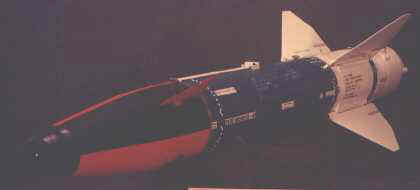
Home Tias Morepod MLV EW Back to Resume
Bulldog

Bulldog Laser Guided Missile
The early 1970's saw the separate development of laser guided close air support missiles by all three services. The Navy's concept was to remove the guidance unit from the USMC radio controlled Bullpup missile that was guided by the pilot after launch with a small joystick like a radio controlled aircraft and replace it with a laser guidance unit. The Bullpup grows up to become Bulldog.
I began to get bored with all the trivial day to day problems of manufacturing with TIAS and was looking for a new challenge when TI won the Bulldog program. Being new to the design team I was given only the aircraft interface to design, but my luck changed when the engineer assigned to develop missile's autopilot left the program and it was also assigned to me.
The auto pilot was essentially an analog computer. There was a four quadrant laser detector on the missile's seeker that told the autopilot if the missile was heading above/below/right or left of the target each laser pulse. There were also inputs from a roll gyro to tell which direction was up as the missile slowly rotated for application of a bias to counteract gravity pulling the missile down and pitch gyros to smooth its flight. The computer then computed the direction and how much to move its canard wings to guide it into the target.
After completing both designs, I learned every detail of the missile and then supported it through its flight test phase which was really rewarding. The first missile launch, I held my breath while the missile was launched high above (my missile/aircraft interface) and then made a direct hit on the target guided by my autopilot. I also enjoyed working very closely with the customer on a daily basis and understanding his side of the story which helped me a few years later when I exchanged my design engineering hat for a marketing hat.
First Live Warhead Bulldog Launch
When launching aircraft with missiles that had live rocket motors, no one except Navy personnel were allowed on the flight line. Then we had our first live warhead shot, everyone wanted to watch and I was assigned to oversee its arming and checkout. I had never done this before and there was no preflight checklist. The pilot is in, the aircraft pointed towards the open desert in case of an accidental missile launch, the missile seeker checks out OK, the aircraft engine is running and the aircraft is ready to take off. But, the Navy ordinance man is having trouble inserting the igniter into the missile's rocket motor and asks me if he can try hammering it in.
I'm terrified, yell, "no, no, no", run in, radio for help and am directed to tell the ordinance man where to find the correct igniter. Then I go back and while waiting for the ordinance man to return, I notice the missile has been assembled with the wrong tail fins which would make it unstable in flight. I take them off, show to the pilot, run back in, find the correct ones, run back out, install them as the ordinance man arrives with the correct igniter. Result: direct hit with our first live warhead against a moving target. Aftermath: the Navy program manager requests that I oversee all aircraft launches with live missiles and I draft the first preflight checklist.
On the East coast test flights, the Navy ordinance man had never installed an igniter in a liquid fuel rocket motor and the Naval flight test director asks me to do it. So with the aircraft pointed out over the ocean, the aircraft engines running, the pilot and navigator have their hands on their helmets, I insert the igniter very gently. Then when the aircraft comes back without launching the missile, yours truly gets to very carefully remove the igniter. In the afternoon, a direct hit on a small, fast moving speedboat, the first one that had ever been directly hit.